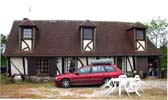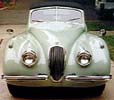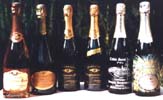|
Need Acrobat Reader for PDF documents?
|
Cooking with magnets - induction hobs
You can read the story of how I got interested in the use of
induction hobs on the
sous-vide cookery page. This page follows my tests of this
remarkable technology to the conclusion that it has nothing to offer for
sous vide and goes on to explain what it is good for.
It’s clever stuff, this. Instead of generating heat in the form of a
flame, a red-hot electric element or microwave radiation, an induction hob
uses a powerful electromagnet to generate heat directly in the
bottom of the cooking pan by inducing (hence ’induction’)
electric currents to flow in the metal - thankfully not the kind that
might electrocute you if you touch the pan! This has to be made of a
magnetic metal, so aluminium is out, and I was a bit concerned that our
Bourgeat pans from Nisbets, which are stainless steel but have an
aluminium sandwich in the bottom to spread the heat more evently, might
not work. No worries: Nisbets actually specify them in the bits about
induction hobs.
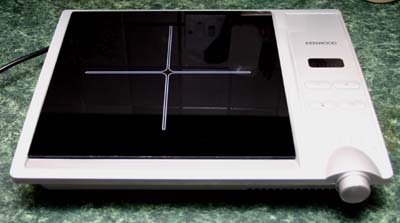
When I got Johnny’s spare hob home, I discovered that it was a
Kenwood one made for the domestic market, and that - unlike the commercial
ones - it had variable power but no temperature control. I immediately
plugged it in, stuck a pan of water on top, switched it on to the lowest
power setting and waited. Not for long: while the top of the hob stayed
stone cold, the water quickly began to steam. Out came the trusty digital
thermometer. The temperature stabilised at about 70°C. Disappointing as
sous-vide can require temperatures as low as 43°C for fish.
Still, I figured that, at constant power, the more water I had in the pan
the lower the temperature would be.
On went a bigger pan with a lot more water - but I still couldn’t get
it to settle much below 70°C. Thwarted, I consoled myself with using the
hob to make stock from the chicken carcasses I’d bought from Johnny, and
which we’d roasted and picked at with such enjoyment at dinner time.
Patricia loathes the smell of chicken stock cooking, which
really isn’t very pleasant. So out went the stockpot and Johnny’s hob to
the garage, where the stock could simmer away all day without offending
anybody.
Next stop: Ebay
So clearly I needed a hob with temperature control as well
as power control. These work using some sort of sensor to measure the
temperature of the pan-bottom.With a week to wait - even I wasn’t
going to trek all the way to Nottingham just for the hob - I did some
research. Our Nisbets’ catering
catalogue had three hobs: one at £599.99, one at £639.99 and a Buffalo
one at a more reasonable £159.99. I learned from the specifications that
these hobs have both power and temperature controls.
I was loath to part with £160 (let alone £600) on spec, so as usual I
resorted to Ebay, where I found just one seller offering
professional-quality hobs. I decided the middle one would suit me best -
the cheapest (in terms of starting bid) was underpowered and the most
expensive seemed identical to the middle one except that it was even
beefier to suit a busy commercial kitchen. Here’s the picture off Ebay of
the one I decided to go for:
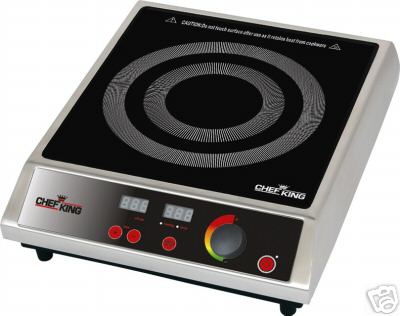
This is a 2.7kW unit with both power and temperature controls,
offering a range from 60 to 240°C, in a robust stainless steel case (the
Kenwood is plastic). It was offered with a starting bid of £65 (about what
the Kenwood costs new) and a retail price of £360 was mentioned. The
beefier one with the same specification quoted a retail price of £580,
which chimes pretty well with what I found at Nisbets.
I had to be poised to bid at 8:30am on Sunday morning, but I was
awake long before then (that’s the Ebay bug for you!). There was one bid
of £65, so I entered a maximum of £85 and watched the clock. At 15 seconds
before the end of the auction I hit the button and moments later the hob
was mine for £65 (no - I don’t know why, either!). Thank goodness there
weren’t any of the daft early bidders who haunt auctions for more popular
consumer items, jacking the prices up for a couple of days before the
auctions end.
On the morning of the 19 March 2008 I got an email from the people I
bought the hob from - ChefKing (UK) Ltd - saying that there was VAT to add
to the price I’d paid. That’s a first on Ebay. I phoned and paid the VAT
with a credit card, making it clear that I wasn’t impressed and that this
would be reflected in my feedback. I couldn’t afford to tell them to take
a running jump as this is a rare bargain. To be fair, I got an email
shortly afterwards to say the item had been dispatched and will be here
the following day.
So, between barrowing loads of rubble from the terrace to the skip
out front (we’re having a conservatory built), I did some research on
sous-vide cooking with induction hobs. After a few false starts I
managed a search string for Google that got me lots of chefs? forums,
loads of relevant stuff and hardly anysites advertising
equipment:
"sous-vide cooking" +induction
If you type it in just like that, with the
quotation-marks and searching the whole web rather than just UK sites,
you’ll find masses of useful stuff. I even found a blog by a female chef
who has cooked sous-vide on an induction hob at Ferran Adria’s
legendary El Bulli restaurant. Authoritative source - or what?
The most useful was a monster web-page from an American
scientist, Douglas Baldwin, that explains
all this, together with real recipes.
I was very disappointed with my purchase. First, it only
allows temperature-control from 60 to 240°C in 20-degree steps -
not exactly a precision tool for sous-vide where, if you believe
the chefs, one degree can make all the difference. If you’re a Blumenthal,
a Bains, a Keller or an Adria, I’m sure this is true. For the rest of us
mortals it may not be quite that bad - but 20 degrees? Also, I noticed
that the hob heats one side of the pan far better than the other, which
can’t be right. Maybe that’s why it was £65 instead of £360. I spoke to
the vendors, who turned out to be a large commercial operation with a full
service department, who were sceptical but said I could send the unit back
for checking if I wished. As things turned out, I didn?t bother.
I used the hob in the garage to cook and reduce some
chicken stock and the uneven heating didn’t seem too bad. I was impressed
that, with the temperature set at 100°C, it maintained a modest boil with
hardly any change as the thermostat cut in and out. I also experimented
with the 1-15 heat setting and found that at the lowest setting a
medium-sized pan held quite steady at around 55°C. So, if the temperature
control wasn’t fine enough, I thought the way forward could be to try
different quantities of water at different power settings.
The three variables would be the hob’s power setting,
the quantity of water (keeping the same pan) and the room temperature. Our
kitchen has a radiator with a thermostatic valve, so the last should be
quite steady. Assuming that it is, then for a given power setting it
should be possible to manage the temperature by varying the quantity of
water, Obviously a large quantity of water should also provide greater
stability, so I guessed that one of our big Bourgeat pans should be used
with plenty of water. Tests would then find the temperature at which this
stabilises for each of the 15 power settings. If this didn’t find enough
temperatures, adding or removing water should provide a means of
fine-tuning the system.
The first trial wasn’t too encouraging. With 5 litres of
water in the smaller stewpan, power setting 1 settled at around 47°C but 2
got to around 70°C. And things got worse: I tipped the water into our
bigger stockpot, from the same Bourgeat range, and got an error from the
hob. Even without water in the pan the error persisted, and I discovered
that, while the bottoms of the rest of the pans have a core of aluminium
sandwiched between two layers of stainless steel, the biggest one has the
aluminium as the contact surface. The hob just won’t deal with this -
somehow it ’knows’ that there isn’t a magnetic layer in contact with it.
So I needed a layer of iron or steel to stand the pan on.
Meanwhile, I managed to get another litre of water into
the smaller pan, but this didn’t help. I decided to try standing the
bigger pan in our large black-iron paella pan. This obviously convinced
the hob’s computer that it was magnetic, but I found that the paella pan
got very hot without transmitting much heat to the stockpot. This was
because the bottom isn?t flat. I tipped half a litre of warm water into
the iron pan: it boiled vigorously but soon settled down. Maybe this would
act as an additional buffer...
Or not! There was still a huge gap between temperatures
with the power set at 1 and 2.
I’m just about out of ideas here - thinking that the hob
will be useful for doing smelly cooking outdoors or in the garage, but no
use at all for sous-vide. Other options are to try to maintain
temperature on the gas hob, which I did for chickens last summer with
reasonable success (above), or in the oven. Luckily the temperature range
I’m after is low enough to leave the digital thermometer probe in the pot
even in the oven for monitoring.
I’m disappointed, though. If the induction hob had
continuously-variable temperature control instead of 20°C steps, I’m sure
I could crack it. I’m almost tempted to take it to bits and
investigate the electronics!
Anyway, for now the induction hob will be used for
smelly cooking outdoors or in the garage, and the
sous-vide experiments will go in different directions.
|
Personal site for Paul Marsden: frustrated writer;
experimental cook and all-round foodie; amateur
wine-importer; former copywriter and press-officer; former
teacher, teacher-trainer, educational software developer
and documenter; still a professional web-developer but
mostly retired.
This site was transferred in June 2005 to the Sites4Doctors
Site Management System, and has been developed and
maintained there ever since.
|
